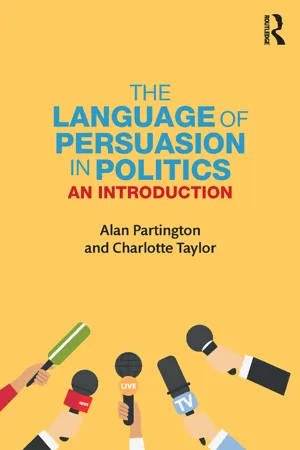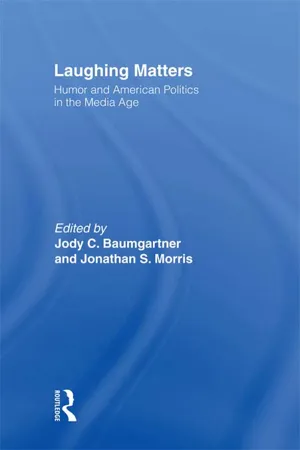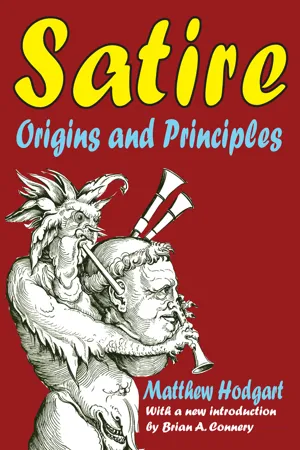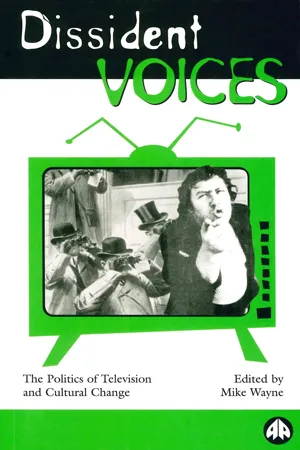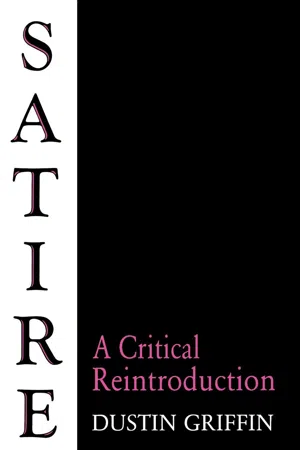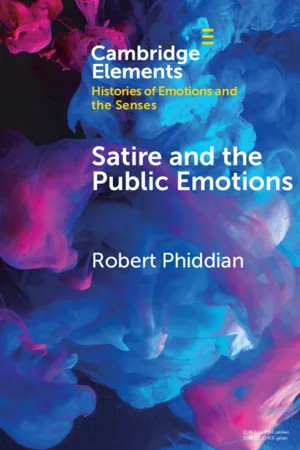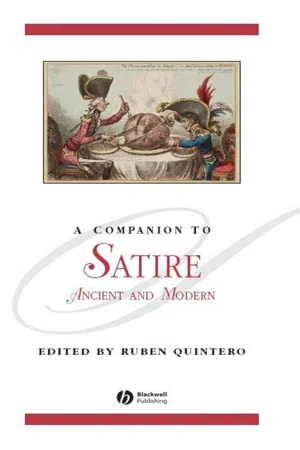Literature
Political Satire
Political satire is a form of literature that uses humor, irony, and exaggeration to criticize and mock political figures, institutions, and societal issues. It often aims to provoke thought and change by highlighting the absurdities and contradictions in politics and power dynamics. Through clever wordplay and comedic elements, political satire offers a critical commentary on the state of the world.
Written by Perlego with AI-assistance
Related key terms
1 of 5
10 Key excerpts on "Political Satire"
- Available until 7 Feb |Learn more
The Language of Persuasion in Politics
An Introduction
- Alan Partington, Charlotte Taylor(Authors)
- 2017(Publication Date)
- Routledge(Publisher)
Taylor (2016) notes that sarcasm is not always judged to be a bad thing. She observed how participants in online forums sometimes referred to their own behaviour as ‘sarcastic’ and portrayed it as a justifiable response to some other person’s aggressive verbal behaviour towards them. Politicians too may pride themselves on their ability to display aggression in a way that is considered both acceptable and entertaining.It may also be viewed as entertaining by those who are not the target, as in the following instance from the UK House of Lords:I have to thank the noble Lord, Lord Carlile of Berriew, for his colourful combination of irony and sarcasm, which I so often enjoyed listening to when he was a Member in another place.(House of Lords 2003)9.3 Definitions of satireHumour in politics is often associated with satire: Satire is a work ‘in which wickedness or folly is censured’ (Johnson 1755). It is a written or spoken form ‘in which human or individual vices, follies, abuses, or shortcomings are held up to censure by means of ridicule, derision, burlesque, irony or other methods’ (Encyclopedia Britannica, www.britannica.com/art/satire ). Various mock satirical ‘newspapers’ or news TV are available online; for example, The Onion satirises current affairs from a US perspective, The Daily Mash and NewsThump from a UK angle.In the terms adopted in this book, satire is also a means of persuasion. A person, behaviour or state of affairs is criticised (evaluated unfavourably) in the hope of persuading an audience that something has to change.Moreover:• In Political Satire, individuals or groups who possess power, authority or at least influence - eBook - ePub
Laughing Matters
Humor and American Politics in the Media Age
- Jody Baumgartner, Jonathan S. Morris(Authors)
- 2012(Publication Date)
- Routledge(Publisher)
No longer was satire associated with magical power, but instead, it was looked upon as an aesthetic pursuit—a literary art form. Even with the introduction of the classical literary satire that has maintained the attention of literary scholars for centuries, “satire has never enjoyed a very high reputation with literary critics,” and “the satirist has skated on the thin edge of censorship and legal retribution.” 15 Today's satirists serve a decidedly different social role, but satire as a form of political speech is as potent as ever. At heart, the role of the satirist remains the same—to attack a society for its “evils.” How, then, does satire differ from other forms of political critique or political humor? To answer this question, one must first develop a definition of satire. This formulation has been notoriously difficult. Robert Elliott, among the most dedicated observers of satire, concluded in a 1962 essay that the “staggering diversity of forms, tones, and materials” precluded any single definition. This conclusion was seconded by Leonard Feinberg, in his 1968 article “Satire: The Inadequacy of Recent Definitions.” 16 Instead, Elliott recommended an approach that would use familiar shared traits among works already designated as satire to arrive at a rubric that would allow the classification of future work. Using Elliott's recommendation, George Test has arrived at a set of shared traits that best captures the “spirit and art” of modern satire, in all its various forms. He argues satire, whether literary or media-induced, rests on a substratum of ritual and folk behavior that continues to be present…. Restricting the study of satire to its literary manifestations has in effect cut off satire from its roots - eBook - ePub
Satire
Origins and Principles
- Matthew Hodgart(Author)
- 2017(Publication Date)
- Routledge(Publisher)
2 The topics of satire: politicsThe most pressing of the problems that face us when we close the book or leave the theatre are ultimately political ones; and so politics is the pre-eminent topic of satire. 'Public affairs vex no man' said Samuel Johnson, but he could not have been more wrong: to some degree public affairs vex every man, if he pays taxes, does military service or even objects to the way his neighbour is behaving. There is no escape from politics where more than a dozen people are living together.There is an essential connection between satire and politics in the widest sense: satire is not only the commonest form of political literature, but, insofar as it tries to influence public behaviour, it is the most political part of all literature. Both are felt to be rather discreditable: the word 'politician' has an unfavourable sense, and satirists keep apologising for their wicked tongues. But both are necessary, since all social and legal systems are in need of continuous reform, and politics is the only means of achieving reform; while only satire can release powerful enough acids to break down the attitudes of mind which hinder reform. Most of the great satirists have in fact been deeply interested in politics, and most have been against the established government of their countries. Those who have supported the government by writing satire against its critics, as Dryden did in Absalom and Achitophel, are usually attacking the alternative kind of government which they can conceive of the critics setting up: thus Dryden, who had lived through the Commonwealth, had a very clear idea of what Whig opposition could lead to, as well as a deep fear of civil war.The enemies of satire are tyranny and provincialism, which often go together. Tyrants dislike any form of criticism, because they never know where it will lead to; and in provincial life free criticism is felt to be subversive of good order and decency. Satire did not flourish under Stalin, nor will it ever flourish in Little Rock or Alice Springs. Political Satire needs a measure of freedom, the background of large cities and some sophistication: political sophistication (both the satirist and his public must understand some of the processes of politics) and aesthetic sophistication (the satirist must be able to contemplate the political scene with humour and detachment as well as with passion, or he will produce only crude polemic). In the great days of fifth-century Athens, these conditions obtained to perfection. Aristophanes commented with unparalleled freedom on the affairs of the day, combining the primitive traditions of satire, the lampoon and the saturnalian travesty, with an extraordinary inventiveness. He represented real citizens like Cleon and Socrates on the stage, and he created wonderful realms of fantasy in which the social and political order is crazily inverted. His earliest extant play The Acharnians was produced in 425 BC when he was barely twenty. It is a powerful plea for an armistice in the bitter war against Sparta, and a violent attack on the warparty led by the demagogue Cleon. Significantly, it begins with a picture of Athenian democracy in action: Dicaeopolis, the anti-war hero, comes to the assembly saying that he has 'decided to shout at, to interrupt and to satirise (loidorein ) every orator who speaks about anything else but peace'. Aristophanic satire is here shown as closely linked with free speech and democratic decision, a link which is maintained throughout his work. Dicaeopolis has no success in the assembly, so he decides to make a separate peace with Sparta, as a private individual - he contracts out. He then earns the hatred of the Chorus of Acharnians, a rural clan who were famous for being warlike and anti-Spartan; but he wins over first half and then the whole of the Chorus by a series of comic arguments to show that the causes of the war are ridiculous. Now won over, the Chorus speak the parabasis - eBook - PDF
Dissident Voices
The Politics of Television and Cultural Change
- Mike Wayne(Author)
- 1998(Publication Date)
- Pluto Press(Publisher)
The arguments that follow have been developed almost entirely from a series of interviews conducted in 1996–97 with comedians, writers and television commissioning editors. 127 What is it and How Does it Work? satire ‘a literary work in which vices, follies, stupidities, abuses, etc. are held up to ridicule and contempt’ and ‘the use of ridicule, sarcasm, irony, etc. to expose, attack or deride vices, follies, etc.’ Webster’s Twentieth Century Dictionary satire n. (Rom. ant.) poetic medley, esp. poem aimed at prevalent vices or follies; a composition in verse or prose lampooning individual(s), this branch of literature, use of ridicule, irony, sarcasm, etc., in speech or writing for the ostensible purpose of exposing & discouraging vice or folly. Oxford Concise Dictionary Two things are worth noting, for our purposes, from these definitions. First, satire is not necessarily funny. And, secondly, satire has its roots firmly embedded in literature . The satire we’re looking at here is not a literary but a televisual form and what we’re looking at is how Political Satire can survive on television. There is quite a lot of Political Satire on television these days but there are not a lot of political satirists. Or rather, comedians and writers don’t seem particularly keen to be labelled as a ‘satirist’. It doesn’t sound very modern, does it? It sounds a bit, well, literary. It’s certainly not the sort of badge that a young edgy, ‘dangerous’, ‘alternative’ comedian with a desperate desire for a career in television should be seen wearing, and few of them are. Outside of Bremner, Fortune and Bird, it’s difficult to think of anyone who one could call a political satirist. Ian Hislop, perhaps Britain’s most clearly labelled political satirist, has established and maintained his reputation mainly through print ( Private Eye ), and it is perhaps significant that on television he courts a well-read ‘old fogeyish’ image. - eBook - PDF
The Challenge of African Potentials
Conviviality, Informality and Futurity
- Yaw Ofosu-Kusi, Motoji Matsuda, Yaw Ofosu-Kusi, Motoji Matsuda(Authors)
- 2020(Publication Date)
- Langaa RPCIG(Publisher)
In keeping with the superiority theory, Political Satire (parody) can be considered an intentional act, even if produced unelaborately, which is accompanied by laughter (but not necessarily all the time) and is intended to arouse a feeling of superiority in the audience over the targeted actors. In such cases, Political Satire constitutes involvement in a symbolic struggle for/against perceived superiority in the political field or an ephemeral escape from political power. Besides using such Political Satire to generate a feeling of superiority, people deploy it to achieve freedom from the targeted powerful political actors (perpetrators). Political Satire can also be considered an act of PPB, which is based on the daily activities of ordinary (not politically strong) people, involving laughter. The meaning of le politique (the political thing) is not necessarily confined to political activities carried out in political society but can also include some politics-related acts played out among non-professional political actors. Thus, the concept of PPB in this chapter means politics-inspired acts that are practised and repeated among the ordinary people outside of conventional political society. Although Political Satire is not usually powerful enough, in material terms, to change the political situation directly, it might be able to gradually influence political circumstances that are based on the symbolic and psychological relationships found in everyday activities. Further, Political Satire may temporarily undermine the symbolic power 4 of rulers. If nothing else, it may bring about an ephemeral and intentional inversion of the targeted authoritarian regime at a critical moment. 147 3. Political Satire in Africa The prevailing political situation and environment inevitably affect the character and trends of Political Satire. In other words, Political Satire mirrors the political situation in a meaningful way. - eBook - PDF
- Maggie McKinley(Author)
- 2021(Publication Date)
- Cambridge University Press(Publisher)
Political Contexts Political Satire David Gooblar It is perhaps surprising how little Political Satire Philip Roth wrote. Over a career that spanned more than fifty years, with more than thirty books – many of them explicitly political and explicitly funny – there’s really only one book that can be truly called a Political Satire. That book, ’s Our Gang, is considered by most of its readers (if it is considered at all) an unmitigated failure. A satire of Richard Nixon, written and published in a white heat of rage before Nixon had even committed his most notorious crimes, Our Gang is a curious work in Roth’s oeuvre. This essay will look at that failure, and the handful of other times Political Satire appears in his work, and try to explain why Roth never fully returned to Political Satire as a writing strategy. But what do we mean when we call something “Political Satire”? Jørgen Johansen, in his entry on the term in the Encyclopedia of Activism and Social Justice, calls it “the deliberate use of comedy for the purpose of attack with an agenda on the part of the satirist,” and, more specifically, “a mode of challenging political actors by making them seem ridiculous.” Satire is distinguished among modes of comedy by the fact that it is used to attack something or someone. Political Satire is distinguished among modes of satire by the fact that it is motivated by a political agenda and that it functions by challenging political actors. In these ways we can see how Political Satire is more than funny writing that touches on political issues (or political writing that happens to be funny). Given the difficulty of defining what is funny and what is not, we need to stay very close to the sense of satire as a sharpened spear, as a kind of writing that means to attack a target. - eBook - ePub
Satire
A Critical Reintroduction
- Dustin Griffin(Author)
- 2021(Publication Date)
- The University Press of Kentucky(Publisher)
6
The Politics of Satire
Having concluded that “reference” to a world of “history” is problematic, we can now look more closely at satire in history. What is the effect of satire on the world outside the text and, in particular, on its political order? Is satire essentially conservative, or subversive? Does it have any effect at all? These questions have received various answers from theorists and commentators. At present there is no clear consensus, and my earlier claims about satire may not appear to bring us any closer to one. If satire is inquiry and provocation, it bears directly on our real moral beliefs; insofar as it is display or play, perhaps it does not touch our everyday lives. Even if we cannot provide definitive answers to these old questions, we need to go on to ask new questions: under what historical conditions does satire typically thrive? Who writes satire, and who typically does not? Whose interests are served?The Conditions for Satire
When we think of satire as a genre, we must guard against the idealist notion that the genre exists apart from its exemplars: satire always emerges at particular times and places. Commentators have in fact long noted that satire seems to belong more to some times than others. It is a commonplace that satire flourished in first- and second-century Rome (at the time of Persius and Juvenal), briefly in the late sixteenth century in England (Donne, Marston, and Hall), the seventeenth century in France (Regnier and Boileau), and the eighteenth century in England (Pope, Swift, et al.). It is also regularly conceded that satire in English declined in the late eighteenth century, that apart from Byron we have had little significant satire proper since about 1750. Can we go beyond the commonplace and, by a process of induction, discover the historical conditions that favor the rise of great satire? The attempt to explain the flourishing of any art by reference to determining historical factors is notoriously risky: great art must involve unaccountable factors such as individual genius and sheer luck. But perhaps we can distinguish the less adequate from the more adequate explanations. - eBook - PDF
- Robert Phiddian(Author)
- 2020(Publication Date)
- Cambridge University Press(Publisher)
This is a social and political licence to insult, not a legal one, and it obtains even today, where all politicians without a police state handy to guard their honour know that they have to roll with the satirical hits. Among recent US presidents, George W. Bush and Barack Obama mostly chose to bear with the vindictive laughter of satirical contempt, anger, and disgust by laughing along with it. Their successor responds instead with counter-anger that polarises the public but does nothing to reduce the satirical attack. This is all part of the furniture in polities where the court of public opinion and passions matters. But in Britain in the 1720s, it was a new thing, and the bravery and novelty of Swift and his publishers should not be underestimated. In this context, Johnson was making a historical statement about something relatively new when he said that Swift ‘shewed that wit, confederated with truth, had such force as authority was unable to resist’. Like Swift, he wanted it to be true and so pretended that it was. Comedy, Satire, and the Range of Gulliver ’ s Indignation The detailed literary history in the previous section is intended to defamiliarise readers’ literary assumptions about Gulliver, and to focus attention on it as volatile political communication. This is to some extent in parallel with Rawson’ s (2014: 9) work on Swift’ s angers where, ‘There’ s a clear recognition that writing is a means of assuaging, not just expressing, uncontainable pressure which, he came to identify with radical human restlessness.’ My goal is more social than Rawson’ s abstract ‘radical human restlessness’, but expressing and assuaging is the dual process I will come to at the end of this section in a model of satirical catharsis. The sense of political moment will permit a reading of some of the most famous bravura passages of the book, to treat them not as familiar combinations of critical cruces but, I hope, freshly as impassioned rhetoric. - eBook - PDF
A Companion to Satire
Ancient and Modern
- Ruben Quintero(Author)
- 2008(Publication Date)
- Wiley-Blackwell(Publisher)
He traditionally presses the point that he is composing his verbal attacks in a treacherous legal, social, and political climate. Yet his poetry – including the poems that explicitly discuss and defend his work – exhibits his learning and his social stability. Every formal aspect of the genre paints the satirist as an insider, despite his cultivation of an outsider’s image. These generic features, though strange and contradictory, are deliberately culti-vated, and point to defining episodes in satire’s historical formation. Prototypes of the Roman satirist figure contribute important techniques to the evolving art of blame, 32 Catherine Keane demonstrating that the satirist must oscillate between aggressive and vulnerable stances, that reiteration of shared values in mockery can be more successful than defiance, that calculated self-referential talk can be employed to manipulate the audience, and that indirection and allusion can speak as loudly as direct criticism. These lessons are learned and absorbed into satire as the occasion and purpose of literary abuse change. To ‘‘define’’ literally means to mark out limits ( fines ), and the story of satire’s encounters with limits begins in the earliest Greek literature. Competing Approaches to Blame: The Lessons of a Myth The first practitioner of mocking abuse in Greek literature is a fictional character, but his experience is illuminating. In Book 2 of Homer’s Iliad, the dispirited Greek army is gathering for an assembly when the soldier Thersites interrupts to rebuke Agamemnon, the leader of the forces (211– 42). This man’s low status is only one of his disadvantages: Thersites is also ugly, a poor orator, and a reputed clown – always saying ‘‘whatever he thought would get a laugh from the Argives’’ (215–16). But he is also bold enough to denounce Agamemnon for using the army’s labor to pile up his own wealth. - eBook - PDF
- Robert L. Caserio, Clement Hawes(Authors)
- 2012(Publication Date)
- Cambridge University Press(Publisher)
The true satirist, Lewis stresses, aims neither for beauty nor, as Huxley and Orwell would have it, for morality; “the greatest satire,” he declares, “is non-moral” (MWA, 85). The Twentieth-century satire 857 satirist’s goal is not to correct society or to show it a better path forward but to represent its contemporary contours as closely and unflinchingly as possible. Satire is a kind of intensified realism, a divested observation of human behavior, partaking more of the qualities of a natural science than of a moral or conventionally aesthetic practice. Humans, closely observed, are to Lewis, as they are to Swift, ugly and unpleasant animals: they are “Apes,” exuding “offensive smells [and] disagreeable moistures,” but rendered more hideous and risible than other primates by their carrying on as though they belonged to a loftier order. At the start of the century, Bergson influentially defined the comic in terms of “something mechanical encrusted on the living”; he saw laughter as our way of collectively punishing those who allow their essential human spirit, their élan vital, to be buried beneath the dehumanizing customs and artifices of social routine. 4 Lewis’s writings on satire constitute a grim, unwelcome inversion of this formula; what makes people laughable is the fact that beneath all their pretentions to vitality and spontaneity, their claims to be more than mere creatures of animal instinct and social habit, they really are just “machines, governed by routine”: tedious, predictable, unreflective, and dull (MWA, 93). But while this negation of our habitual self-regard may provoke a kind of laughter, it is not, says Lewis, “a genial guffaw”; “it is tragic, if a thing can be ‘tragic’ without pity or terror” (MWA, 92). A literature without beauty, without morality, without geniality, without pity or terror sounds like pretty hard going, and it often is with Lewis’s fiction.
Index pages curate the most relevant extracts from our library of academic textbooks. They’ve been created using an in-house natural language model (NLM), each adding context and meaning to key research topics.
